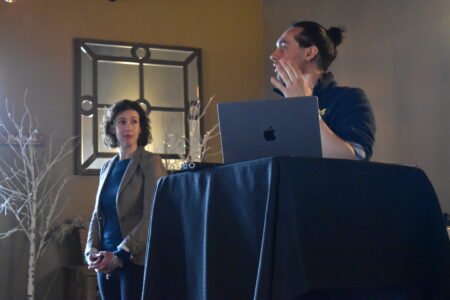Summer Youth students learn lava flows, mining

During a Friday tour of the Quincy Mine, SYP students found that even the fun aspects of the tour were educational. Here, the students got an opportunity to push and dump a 1,500-pound ore tram car, which is loaded to less than full capacity with 1,500 pounds of mine rock. During active mining, one man would load a similar or identical car, push it to the mine shaft, and lift and dump the contents it into a skip that would take the rock to surface. (Graham Jaehnig/Daily Mining Gazette)
HANCOCK – A group of high school students with the Summer Youth Program spent some time underground at the Quincy Mine Friday morning to learn about lava flows and 19th century mining.
Don Lee, PhD student in the Environmental and Energy Policy Program at Michigan Technological University, who led the group, said the students in this particular group are were studying climate sustainability. Lee said they are looking at industrial and post-industrial processes as well as food systems.
“I mean, we just kind of cover the whole gamut of sustainability,” said Lee.
The mine tour at the Quincy, he said, is let the students learn a bit about the ramifications of industrial processes in terms of pollutions and the stamp sands emissions that are present throughout the Upper Peninsula mining region.
The SYP, said Lee, is a program by which Michigan Tech brings in high school students from across the Midwest, including students from the local area, Lower Michigan, Minnesota, and Indiana.
The SYP offers the students various programs to expose them to different academic programs, sharing with them different professional opportunities that they might be able to pursue after high school.
The mine tour of the Quincy Mine Hoist Association provides an excellent classroom for the students, said Association Manager Tom Wright, because of the wide array of examples of Keweenaw geologic formations the mine provides.
The students were shown the results of lava flows that occurred over millions of years, seeing the where the tops of previous flows were covered by succeeding flows, as well as being able to touch them to feel the differences between the older and newer flows.
They also learned how these once flat flows wound up being pitched on a 56-degree angle from horizontal, as did the copper lodes.
Students were also shown a stope, a large mined out area, where copper was extracted from the rock formations.


